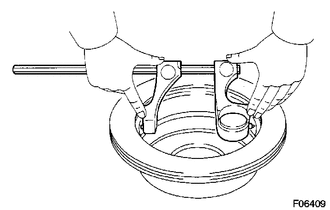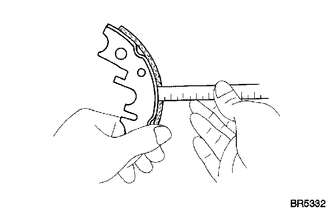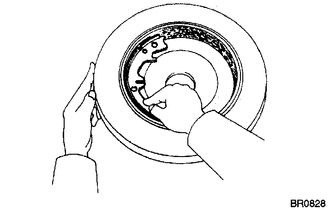Toyota 4Runner: Inspection
INSPECTION
PROCEDURE
1. CHECK BRAKE DISC INSIDE DIAMETER
|
(a) Using a brake drum gauge or equivalent, measure the inside diameter of the disc. Standard inside diameter: 210 mm (8.27 in.) Maximum inside diameter: 211 mm (8.31 in.) If the inside diameter is more than the maximum, replace the disc. |
|
2. CHECK PARKING BRAKE SHOE LINING THICKNESS
|
(a) Using a ruler, measure the thickness of the shoe lining. Standard thickness: 4.0 mm (0.157 in.) Minimum thickness: 1.0 mm (0.0394 in.) If the lining thickness is less than the minimum, or if there is severe or uneven wear, replace the brake shoe. |
|
3. CHECK BRAKE DISC AND PARKING BRAKE SHOE LINING FOR PROPER CONTACT
|
(a) Apply chalk to the inside surface of the disc. Rub the brake shoe lining against the disc and check that full contact is achieved between the brake shoe and disc (chalk is transferred to the entire brake shoe lining). If the contact between the brake disc and the shoe lining is improper, make adjustments using a brake shoe grinder or replace the brake shoe assembly. |
|
 Disassembly
Disassembly
DISASSEMBLY
CAUTION / NOTICE / HINT
HINT:
Use the same procedure for the RH and LH sides.
The procedure listed below is for the LH side.
PROCEDURE
1. REMOVE REAR WHEEL
2. DISCO ...
 Reassembly
Reassembly
REASSEMBLY
CAUTION / NOTICE / HINT
HINT:
Use the same procedure for the RH and LH sides.
The procedures listed below are for the LH side.
PROCEDURE
1. INSTALL PARKING BRAKE SHOE ...
Other materials about Toyota 4Runner:
Installation
INSTALLATION
CAUTION / NOTICE / HINT
HINT:
Use the same procedure for the RH and LH sides.
The procedure listed below is for the LH side.
When installing the clip, heat the vehicle body and clip using a heat
light.
Standard:
...
Removal
REMOVAL
CAUTION / NOTICE / HINT
HINT:
Use the same procedure for the RH and LH sides.
The procedure listed below is for the LH side.
PROCEDURE
1. DISCONNECT CABLE FROM NEGATIVE BATTERY TERMINAL
CAUTION:
Wait at least 90 seconds after d ...
0.0073



